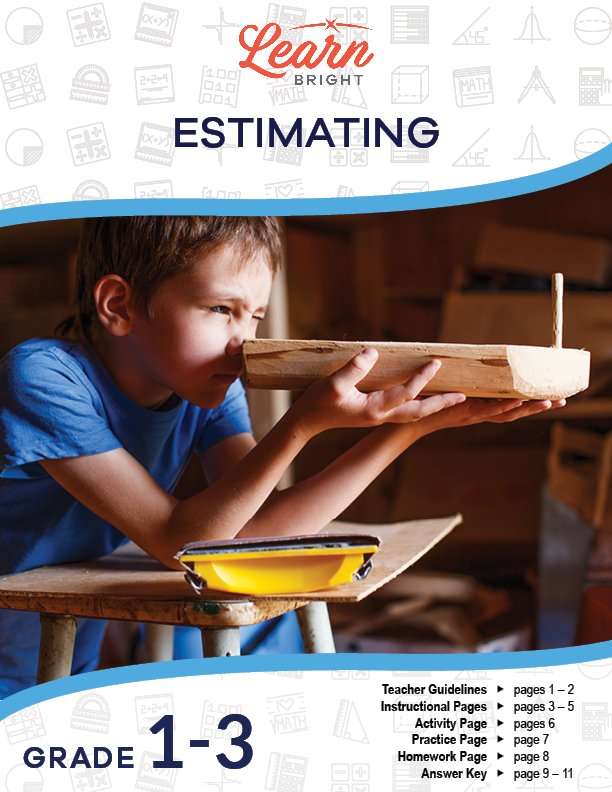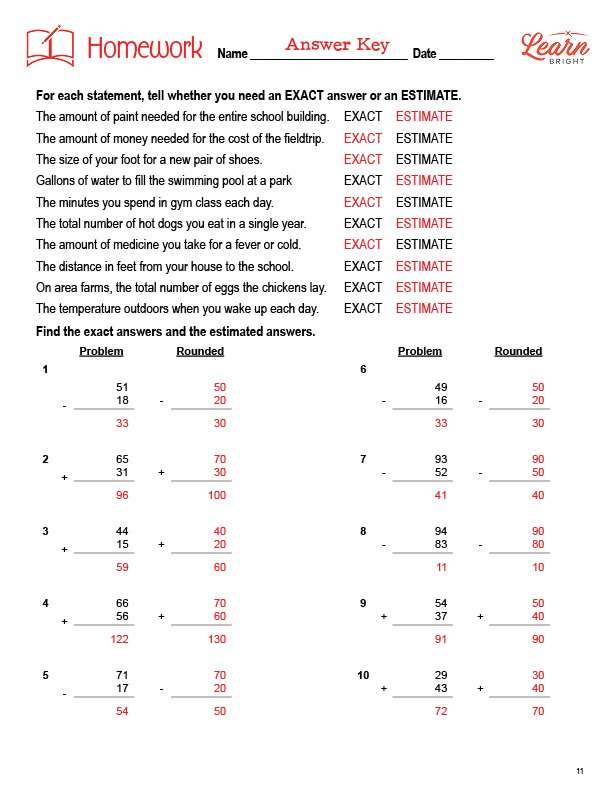Description
What our Estimating – Grades 1-3 lesson plan includes
Lesson Objectives and Overview: Estimating – Grades 1-3 enables students to define and use estimation for adding and subtracting by first rounding a number. At the end of the lesson, students will be able to define and use estimation. The students will be able to use estimation for adding and subtracting by first rounding a number. This lesson is for students in 1st grade, 2nd grade, and 3rd grade.
Classroom Procedure
Every lesson plan provides you with a classroom procedure page that outlines a step-by-step guide to follow. You do not have to follow the guide exactly. The guide helps you organize the lesson and details when to hand out worksheets. It also lists information in the blue box that you might find useful. You will find the lesson objectives, state standards, and number of class sessions the lesson should take to complete in this area. In addition, it describes the supplies you will need as well as what and how you need to prepare beforehand.
Options for Lesson
Included with this lesson is an “Options for Lesson” section that lists a number of suggestions for activities to add to the lesson or substitutions for the ones already in the lesson. Several of the suggestions relate to the activity worksheet. For the activity, students may work in smaller or larger groups and you can add additional tasks. An optional addition to the lesson is to take your students outdoors to practice estimation. You can also use multiple jars of treats for the lesson closing and change the sizes of treats in each jar.
Teacher Notes
The teacher notes page includes a paragraph with additional guidelines and things to think about as you begin to plan your lesson. This page also includes lines that you can use to add your own notes as you’re preparing for this lesson.
ESTIMATING – GRADES 1-3 LESSON PLAN CONTENT PAGES
What is Estimation?
The Estimating – Grades 1-3 lesson plan includes three content pages. When we solve the problem 2 + 2 = 4, we find an exact answer. Two plus two can only equal four, it cannot be higher or lower than that. If you and three friends each want one piece of pizza, you need exactly four pieces because 3 + 1 = 4.
However, sometimes we don’t need an exact answer, and just need to get close to the exact answer. This is called estimation. We sometimes call estimations guesses, and they are based on information that you already have. For example, you might want to guess how much a video game will cost. If you know how much other video games cost, you can make a guess about how much this video game will cost based on that information.
Estimation is finding numbers or answers you can use that are close enough to the right or exact answer. You are not trying to get the right or exact answer. Estimates are answers that are good enough and might be used when you’re in a hurry.
Sometimes you need an exact number, but other times an estimate is okay. You might need an exact number if you plan on giving exactly 2 cookies to each of your classmates. On the other hand, your principal might use an estimate if they want to give two cookies to everyone in the school including students, teachers, and staff.
How Do You Estimate?
There are several different ways that you can estimate. Different people prefer different methods. However, no matter which method you use, your estimate needs to make sense. To estimate for addition or subtraction problems, it’s best to begin by rounding the numbers. This will make it easier to add or subtract.
For example, 9 + 17 = 26, but you know that 9 is closer to 10 and 17 is closer to 20. When estimating you add or subtract the rounded numbers: 10 + 20 = 30. 30 is not the exact answer, but it’s a close estimate. If you want to buy a shirt that costs $9 and a pair of pants that cost $17, you can estimate to figure out that you will need about $30 to buy them.
Rounding Review
When you round, you look at the digit to the right of the place value you’re rounding. For example, if you want to round 18 to the nearest 10, you would look at the 8. Since 8 is 5 or above, you round up to 20. However, you would round 54 down to 50 because 4 is 4 or below.
You use the same process when rounding hundreds. For example, if you want to round 178 to the nearest 100, you would look at the 7. Since 7 is 5 or above, you round up to 200. You would round 339 down to 300 because 3 is 4 or below.
You can use rounding to estimate with addition and subtraction. For example, you might want to estimate the difference between 465 and 220. First, round 465 to 500 and 220 to 200. Next, subtract: 500 – 200 = 300. You just estimated!
The lesson includes a few more examples. The process is the same for all of them—round the numbers and then add or subtract to fine the estimate.
Other Kinds of Estimation
You can estimate for other purposes as well, like measuring the length of something. Someone might want to know the size of their cell phone. To estimate, they could use a part of their finger because they know it’s around one inch long. This will not give them an exact answer, but it will give them an estimate.
Some other things you can estimate are the temperature outside or the measurement of ingredients when cooking. Farmers might estimate how many crops they can plant in a given field. You might estimate how long it will take you to do your homework.
Accurate estimation takes practice. The more you practice, the faster it will be. You can practice by estimating things in your everyday life and comparing them to the exact answer.
ESTIMATING – GRADES 1-3 LESSON PLAN WORKSHEETS
The Estimating – Grades 1-3 lesson plan includes three worksheets: an activity worksheet, a practice worksheet, and a homework assignment. You can refer to the guide on the classroom procedure page to determine when to hand out each worksheet.
CLOSE OR NOT ACTIVITY WORKSHEET
For the activity worksheet, students will use the supplies given to them by their teacher and follow the directions for each task. For each, they will first estimate and then find the exact answers. They will then determine if their estimate was close or not.
EXACT AND ESTIMATE PRACTICE WORKSHEET
The practice worksheet asks students to estimate the sum or difference by rounding each number to the nearest ten. They will then find the exact answers and the estimated answers.
ESTIMATING – GRADES 1-3 HOMEWORK ASSIGNMENT
For the homework assignment, students will look at different statements and tell whether you need an exact answer or an estimate in each scenario. Next, they will find the exact and estimated answers to various addition and subtraction problems.
Worksheet Answer Keys
This lesson plan includes answer keys for the activity worksheet, the practice worksheet, and the homework assignment. If you choose to administer the lesson pages to your students via PDF, you will need to save a new file that omits these pages. Otherwise, you can simply print out the applicable pages and keep these as reference for yourself when grading assignments.









